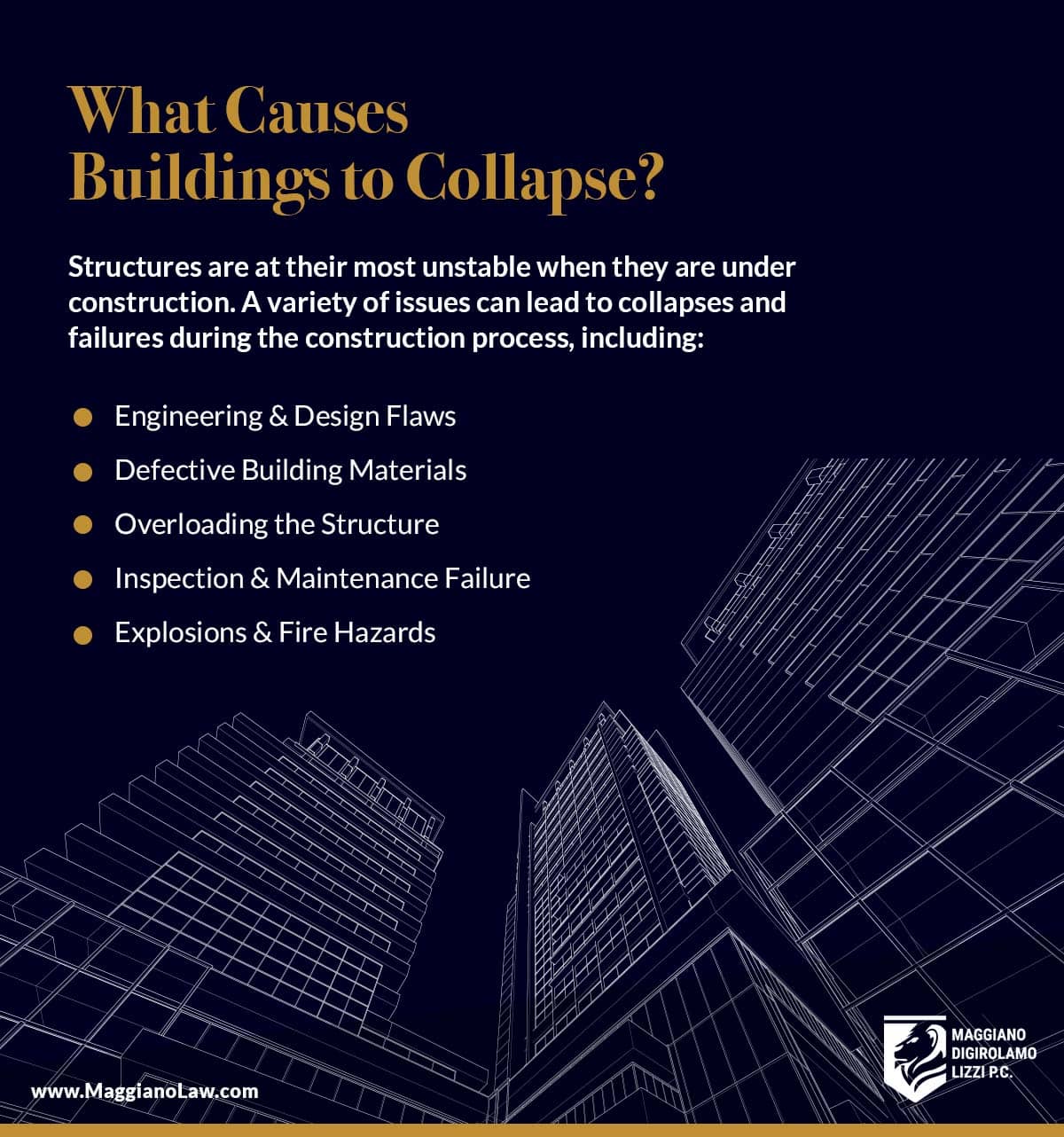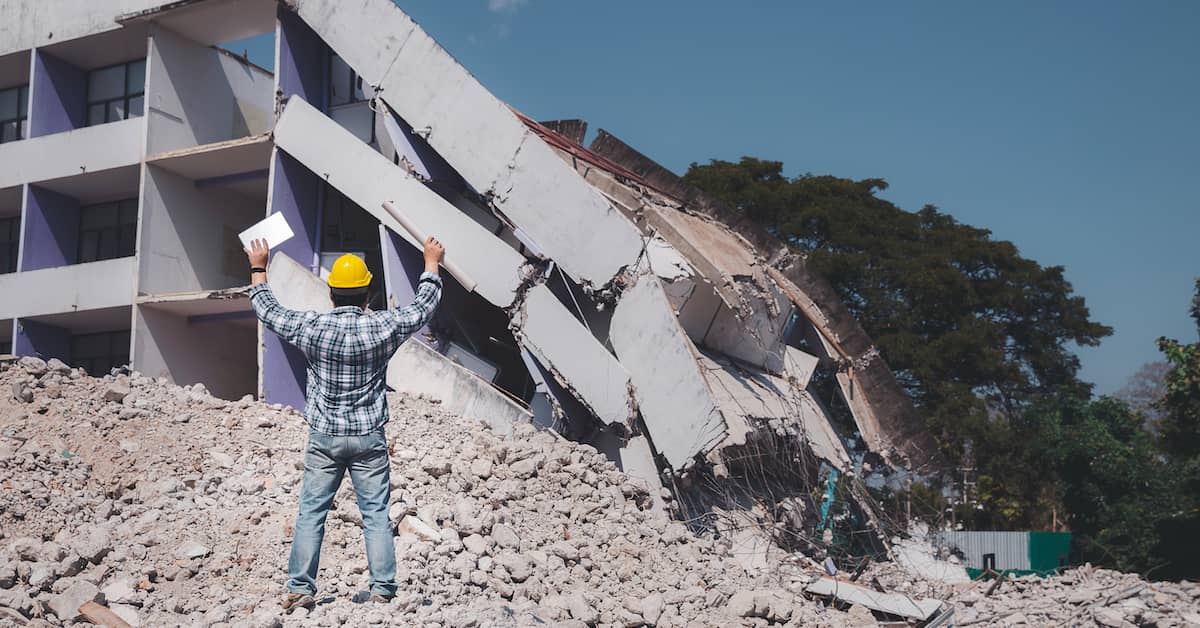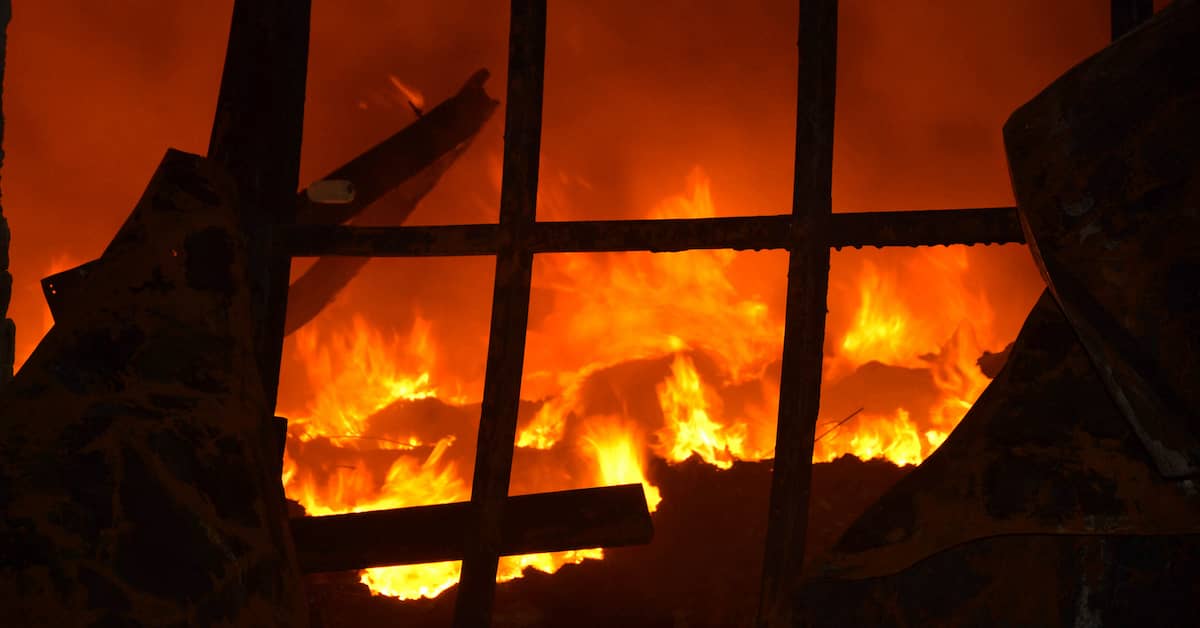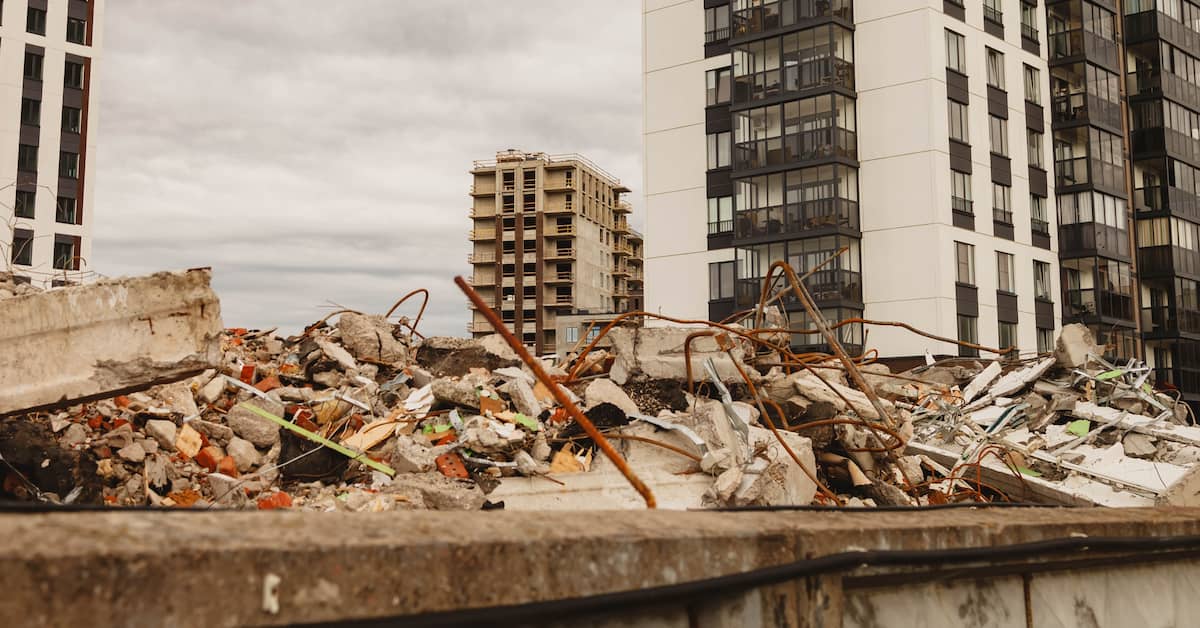Dedicated New Jersey Construction Accident Lawyers
Construction sites can be dangerous places to work. We were reminded of this right in our own backyard in September 2021 when two workers were seriously injured in a scaffolding collapse in Fort Lee.
Fort Lee structural failures and collapses are not the only hazards that impact the safety of construction workers. Fires, explosions, and other incidents can also cause serious injuries and even death.
If you or someone you love has been harmed as a result of a Fort Lee construction site collapse or other accident, Maggiano, DiGirolamo & Lizzi can help. Our construction accident lawyers can review your case for free and fight for the full compensation you deserve.
Fort Lee Construction Site Collapse
Structures are at their most unstable when they are under construction. A variety of issues can lead to collapses and failures during the construction process, potentially resulting in:
- Structural Collapses
- Building Collapses
- Scaffolding Collapses
- Trench Collapses
- Foundation Collapses
- Deck Collapses
- Wall Collapses
- Roofing Collapses
- Fire Escape Collapses
Any one of these disasters can send construction workers hurtling to the ground and/or trapped beneath tons of rubble. Passersby and people in neighboring buildings are also at risk for serious and even fatal injuries. Nearby buildings are practically guaranteed to be hit by debris when a large structural failure occurs and collapses, potentially leading to a secondary collapse.
Construction collapses are serious in nature. When they happen, the public, the government, and the media demand answers. It should come as no surprise, then, that OSHA conducts thorough investigations of construction site collapses.
Why Does a Building Collapse During Construction?
Multiple issues can cause both permanent and temporary structures on a construction site to collapse and fail. Some of the common causes include:
- Engineering/Design Flaws: Roof collapses and more can occur when poor designs and architectural failures are part of a construction project. A structure can collapse completely when it has been unstable for many years and continues to decline.
- Defective Building Materials: Sometimes a construction company will use cheap materials to save on costs. However, this jeopardizes durability and can lead to a building collapse.
- Overloading the Structure: Care must be taken to ensure that any structure can support the weight and transfer the forces placed upon it. If the weight exceeds the load threshold, the structure may collapse.
- Inspection and Maintenance Failure: Regular inspections must be conducted on buildings. However, what happens when a building owner does not keep up with these inspections? The neglect may lead to a collapse, ending in injuries or death for workers as a result.
- Explosions/Fire Hazards: Owners must always make sure that gas leaks and hazards are addressed on building sites. In the absence of these safety protocols, an explosion may lead to a collapse of certain structures.
Some structural failures and collapses are more prone to happen than others. For example, OSHA has emphasized how important it is for structural engineers to “specify the order and manner of replacing existing diagonals and strut members” during retrofitting and reinforcement of cellular and communication towers. When workers have used their own judgment in these projects, the results are often “disastrous” (according to OSHA).
Mast climbing platforms are another structure that can collapse when contractors fail to take necessary care. OSHA calls for an “abundance of caution and supervision during dismantling of mast climbing platforms, not to overload the platforms causing failure of the mast.”
Adverse weather is another hazard recognized by OSHA as a key contributor to collapses and other accidents on construction sites. Contractors and engineers are advised to “consider turbulent winds causing uplift and vortex in areas exposed to tropical storms and hurricane” before putting workers in danger. In addition, OSHA has found that crane collapse can occur when the contractor fails to position “the boom and jib in the face of impending wind in accord with the crane manufacturer’s instruction.”
Why Do Scaffolds Collapse?
Scaffolding is a temporary structure erected on construction sites to enable workers to perform jobs at heights without constantly having to move ladders, heavy equipment, etc. Unfortunately, the temporary nature of scaffolding means that owners and contractors often fail to exercise the necessary care in construction to prevent failures and collapses.
Many different issues can lead to a scaffolding accident on a New Jersey construction site collapse, including:
- Use of improper materials
- Errors in erecting and assembling the scaffolding
- Violations of OSHA Standard 1926.451, which sets forth the requirements for workplace scaffolding
- Failure to inspect the scaffolding after construction
- Inadequate supervision of workers
- Overloading the scaffolding
- Failure to re-inspect the scaffolding and perform necessary maintenance
- Inadequate training of workers who perform jobs while on a scaffold
- Poor management of the construction site, resulting in collisions with the scaffolding by vehicles and heavy equipment
- Ignoring recall notices from the manufacturer and keeping unsafe scaffolding in operation
The results of a scaffolding accident are frequently catastrophic. A search of the OSHA website for the term “scaffold collapse” reveals that all of the qualifying incidents recorded by OSHA over the last two years resulted in the death of at least one worker. Though many of these accidents involve falls from scaffolding and other heights, scaffolding collapses also account for a high number of injuries and fatalities.
Who Is Responsible If a Building Collapses During Construction?
Construction site collapses are high-profile events. One of the first questions anyone asks is “Who is responsible?”
Determining the answer to this question is particularly important for construction workers injured in the collapse, as well as the families of those who died in the accident. A construction site collapse accident lawyer can investigate to determine if one or more of the following parties contributed to the incident:
- The owner of the property or premises
- Contractors and subcontractors involved in construction
- Architects and engineers
- The manufacturers of defective materials and supplies
In New Jersey, employees who are hurt on the job cannot sue an employer for the injuries they sustain in workplace accidents; workers’ compensation is their only recourse. However, if a structural failure and collapse is caused by the negligence of one or more third parties (like those mentioned above), workers and their families can pursue full recovery of damages.
Unlike in a workers’ compensation claim, fault must be established for a third-party personal injury or wrongful death claim to succeed. Construction accidents are complicated, requiring specialized skills and training to investigate effectively.
If you were injured or lost a member of your family in a Fort Lee construction collapse, it is crucial to seek legal guidance as soon as possible. Our experienced construction accident lawyers know what evidence is needed and which experts to hire to determine how the accident happened and who is liable. We fight for full compensation on your behalf.
Construction Site Fires
A fire on a construction site puts workers in serious danger. In addition, depending on where the fire starts and how it spreads, structures on the construction site may also become damaged, unstable, and prone to failure.
OSHA Standard 1926.150 establishes the rules employers are required to follow for fire prevention and protection in the workplace. Unfortunately, employers in the construction industry often fail to abide by these regulations.
Without the necessary preventative and protective measures in place, a small fire can become a deadly inferno. Some of the most common causes of fires on construction sites include:
- Careless cooking – many fires start because workers are cooking on an open flame near combustible materials
- Faulty electrical wiring
- Leaving tools, equipment, and machinery unattended
- Improper storage of paint, lacquer, solvents, thinners, and other flammable chemicals
- Performing work activities (such as welding, cutting, etc.) too close to combustible materials
- Defective tools and equipment
- Failure to clean tools and equipment
- Improper disposal of materials
- Unsafe storage of hazardous materials
- Discarding lit cigarettes
Many fire hazards originate due to errors on the part of construction workers. However, in other cases fires start because of negligence on the part of employers, contractors, and subcontractors, including:
- Failure to clear flammable waste from the premises
- Not providing appropriate receptacles (such as metal bins) for the disposal of oily rags and other materials
- Failure to inspect tools and machinery
- Providing inadequate training for workers on fire safety, safe operation of equipment, storage of flammable and combustible materials, etc.
- Violating OSHA rules for fire prevention and protection
The most recent report from the National Fire Prevention Association recorded 3,840 fires in buildings under construction and 2,580 fires in structures being renovated over a five-year period. On average, construction and renovation-related fires resulted in 12 deaths, 101 injuries, and $408 million in property damage each year.
Construction Site Explosions
Fires and explosions are the sixth leading cause of death in workplace accidents. Over a period of five years, the U.S. Bureau of Labor Statistics recorded 496 worker fatalities in fires and explosions, accounting for just over 10% of employment-related deaths. Explosions can also destabilize buildings and structures on the construction site, putting workers not in the immediate vicinity of the explosion in jeopardy as well.
Construction sites contain a number of hazards that can cause fires and, even worse, explosions. This can lead to a wide range of accidents, including:
- Chemicals Explosions: Vapors from solvents, fuels, and other flammable chemicals can explode if they come into contact with an ignition source.
- Pressurized Container Explosions: These explosions affect vehicle tires, pipes, and water tanks. They are caused by overpressurization, cutting, drilling, and welding.
- Arc Flashes and Blasts: Also known as electrical explosions, arc flashes and blasts are caused by switchboards and transformers when electrical malfunctions occur or a circuit is formed through contact with overhead power lines.
- Blasting Explosions: Explosives have multiple uses in construction as well as demolition. Of course, mishandling of explosives can lead to accidental explosions.
Workers in close proximity to a construction site explosion are highly unlikely to survive. Those who do are often left with serious burn injuries, broken bones, hearing and vision loss, injury to the neck and back, traumatic brain injuries, and more.
What Happens After a Major New Jersey Construction Site Accident?
In the aftermath of a construction collapse or a fire or explosion on a construction site, multiple parties will be trying to get to the truth. OSHA and other agencies will investigate, as will the companies involved in construction and their insurers. Although these investigations might unearth the facts of the accident, very little attention will be paid to the best interests of the victims.
Workers and their families may assume that workers’ compensation benefits are the only option after a construction site accident. Although workers’ comp pays medical expenses, a portion of the employee’s lost wages, and benefits in the event of permanent disability, many losses are not covered.
Recovering full compensation will require bringing a claim against any and all liable parties, including owners, contractors, subcontractors, etc. This should not be done without a knowledgeable construction accident lawyer.
Our attorneys can seek to recover all of the damages you have suffered as a result of the construction collapse, fire, or explosion caused by a negligent third party, including:
- All medical expenses present and future
- The cost of medical-related travel
- Modifications to your home and vehicle
- All lost wages to date
- Loss of earning capacity
- The cost of hiring outside professionals for household tasks, medical care, etc.
- Pain and suffering
- Disability
- Scarring and disfigurement
- Emotional distress
The process of investigating the construction accident, collecting evidence, consulting experts, and calculating damages takes time. Your attorney may be able to negotiate a favorable settlement on your behalf, or it may be necessary to take your case to trial.
It is important to be patient throughout the course of your claim. An experienced attorney can answer your questions and help you make informed decisions on what to do next.
Contact Our Fort Lee Structural Failures & Collapses Lawyers Today
When you have been involved in a construction accident, you want an attorney with experience who you can trust. At Maggiano, DiGirolamo & Lizzi, we have worked to help many who have been involved in construction accidents through the years.
You deserve compensation if somebody else’s negligence caused your injuries or the death of a family member. Our attorneys have recovered millions of dollars in verdicts and settlements on behalf of construction workers and their families. We look beyond workers’ compensation to calculate all of your losses and hold all third parties accountable.
Please call Maggiano, DiGirolamo & Lizzi at (201) 585-9111 if you or a loved one suffered harm in a construction site collapse, fire, or explosion. Your initial consultation is FREE, and you pay nothing unless we recover on your behalf. Our construction accident lawyers serve clients in Fort Lee and throughout New Jersey.



















